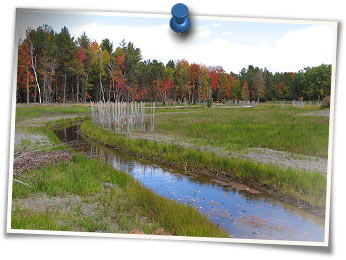
Moses Creek Restoration
For more than 70 years, Moses Creek flowed in a drainage ditch through the eastern portion of Schmeeckle Reserve. A major restoration project in summer and fall of 2010 re-created the natural meanders of the stream and restored 17 acres of historic wetland floodplain. New trails and boardwalks provide access to the wetland, which has been planted with native trees, shrubs, and marsh vegetation.
The $900,000 restoration was funded as a mitigation project by the Wisconsin Department of Transportation. In 2013, the project was awarded an
Environmental Excellence Award in Collaboration and Partnership by the Federal Highway Administration.
Click here to view photo galleries of restoration
Background
In the late 1800s, Moses Creek was ditched in an effort to drain wetlands for farming. During summer droughts, the streambed was dry and sterile. During periods of high rain and snow melt, the creek could swell to the top of the ditch, and on occasion flooded the Brillowski subdivision east of the Reserve. In the 1970s, floodwaters clogged storm sewers on campus, filling basements and spilling over athletic fields.
Goal of the Project
The goal of the project was to restore a meandering stream and adjacent wetlands, which would:
- Improve drainage with flood-prone areas north of campus
- Provide high-quality habitat and increase the diversity of wildlife and plants
- Offer unique educational opportunities for students and the community
- Improve the quality of aquatic habitat
- Serve as a pleasing recreation corridor for the community
Accomplishments
- About 0.8 mile of Moses Creek was restored to a natural meandering waterway. The channel is narrow and shallow, allowing the creek to carve its own path over time.
- Approximately 17 acres of new wetlands were created along Moses Creek. This involved removing trees and excavating 2-3 feet of soil from the project area to improve floodplain functions.
- A 50-100 foot buffer of trees was left around the edge of the restoration area. Large specimen trees were identified and included as islands and peninsulas in the wetland floodplain.
- Native trees, shrubs, and wetland vegetation were planted to stabilize the excavated area, enhance habitat, and provide a visual buffer.
- Scrapes and depressions were excavated in the wetland areas, creating pools of water for wildlife.
- A half-mile, 10-foot-wide boardwalk was constructed as part of a new trail system that provides access to the restored wetlands and connects to the Green Circle.
- Invasive species were managed during the construction and will continue to be controlled until 2021.
Restoration Timeline
-
April 2008-October 2009: Collected data on study area, including wetland delineation and ground water monitoring
-
December 2008-May 2009: Stakeholder, neighborhood, and public informational meetings
-
February-March 2010: Oak trees in the study area cut to reduce the risk of introducing oak wilt
-
July 26-December 1, 2010: Excavated the stream channel and 17 acres of wetlands. Native trees, shrubs, and wetland vegetation planted. New boardwalk constructed.
- May 11, 2011: Grand Opening celebration
-
Spring 2011-Fall 2021: WisDOT contractors will monitor and control invasive species in project area and buffer zone
Map of Restoration Area
 New trail map of restored area
New trail map of restored area
Documents and Studies
Original restoration reports and plans
Annual Monitoring Reports
Research Studies
Other
